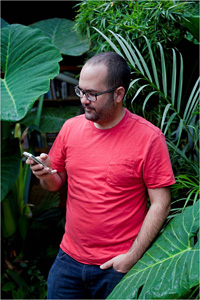Open Studio
We Are the Space We Live In: Analyzing your environment
Activity
This series of assignments brings students to visually understand how architectural space informs a culture. The assignments are organized in two distinct phases. First, students will learn about the concept of a Photographic Project. Next, they will explore ideas about the interpretation of space through the capture and group analysis of images.
Media
Photography
Materials
Camera, tripod, small black & white or color laser or inkjet desktop printers
Preparation
Divide your class into pairs. Within each pair, both students must share responsibility for taking the pictures. One student will operate the camera, while the other will serve as a critical advisor who will help ensure the quality of the pictures.
Camera Settings
Set your camera to a function mode that you are familiar with: Av (aperture value), Tv or S (Time value or Speed), or on P. Place the camera on a tripod and make sure the images are produced using a standardized camera position, height, angle, and function mode, as in the examples below.
Try not to use flash. Instead, use the tripod to help you create images in low light while avoiding camera movement. Set the camera to create JPEG files of medium or low quality that will enable you to quickly print two low-resolution 4 x 6 prints on sheets of letter-size paper. (The images can later be trimmed to make 4 x 6 prints.)
Download This Activity
About Open Studio
Designed by practicing artists, the Open Studio classroom activities aim to connect high school teachers and students with key ideas and issues in contemporary art. See all of the Open Studio activities.
Assignments
Assignment #1

Search for elements of the architecture or furniture in your school that appear throughout the building. Select at least 20 different variations of these elements to photograph. Examples might include lockers, doors, windows, the space under chalkboards, chairs, door knobs, etc. After photographing these elements, return to the classroom and select the 10 best images and print them out. Cut them out as single images, and use the cut-outs to create a thematic linear sequence. The images can start in one color and transition to a second or third, go from a smaller size to a bigger size, or change in any way that prompts a second look at how the objects are read as a set of pictures. Keep the rules used to order the images between you and your partner. Finally, ask a member of another group to compare your sequence to the original photos, and decipher the logic behind the way the images are sequenced.
Assignment #2

Alejandro Cartagena, Between Borders Series, 2009
Select another 20 different elements of the architecture or furniture in your school to work with. Photograph each one using a similar composition — for example, take each photo from the same angle, distance, or perspective. Return to the classroom and select the 10 best images and print them out. Cut them out as single images, and use the cut-outs to create a new thematic linear sequence. Keep the rules used to order the images between you and your partner. Finally, ask a member of another group to compare your sequence to the original photos, and decipher the logic behind the way the images are sequenced.
After completing both assignments, discuss the following questions as a group: Which series of images was easier to understand? Why? Was it the formal consistency? The subject matter? The logic behind the sequencing? In which series was the subject matter and the sequencing easiest to understand?
Assignment #3
This activity requires keen observation of the space surrounding you. How and why you photograph what you will photograph is up to you, but your decisions must be explained when you present your work to your class. You might ask yourself the following questions as you contemplate what to photograph: Does the space I live, study, or work in shape my daily activities? How does that space make me feel? Why? Are you responding to the height of the ceilings, the shape of the windows, the color of the walls, or details about the furnishings?
Some theorists think of spaces as something we build with certain ideals and functions in mind, but such constructions eventually transform who we are. The city (and space), as the noted urban sociologist Robert Park once wrote, is “man’s most consistent and, on the whole, his most successful attempt to remake the world he lives in more after his heart’s desire. But, if the city is the world which man created, it is the world in which he is henceforth condemned to live. Thus, indirectly, and without any clear sense of the nature of his task, in making the city man has remade himself.” What does your environment mean to you? Produce a series of 10 images that represent your answer to this question. Print them out and sequence as before. Ask a second pair to try and determine the idea behind your photographs. Then present your work and the ideas behind it to the class.




